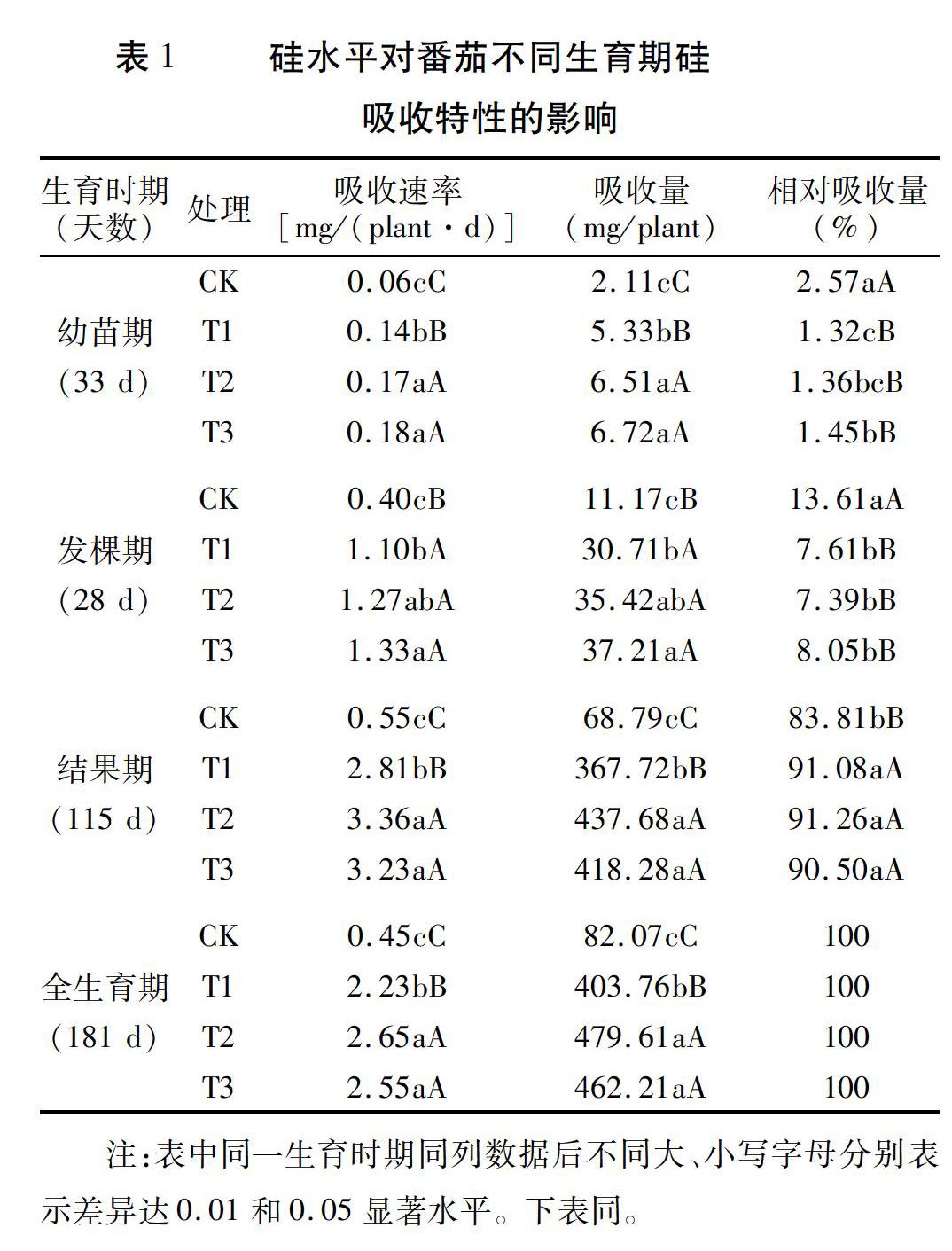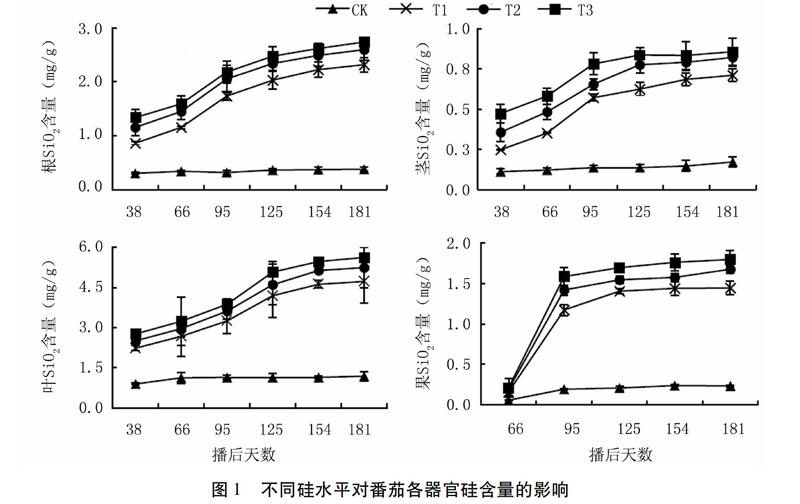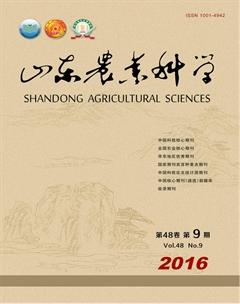硅對番茄果實發育及硅吸收特性的影響
高榮廣 曹逼力


摘要:為探討硅對番茄的生理效應,本試驗采用水培方式,研究了營養液硅水平對番茄果實發育及硅吸收分配規律的影響。結果表明,與對照(CK)相比,隨營養液硅水平的提高,番茄植株各器官硅吸收量顯著增加,果實成熟期縮短2~3天,坐果數及單株產量增加,但單果質量下降;硅水平過高(1.8 mmol/L)不利于植株生長,單株產量以1.2 mmol/L硅處理最高,較對照增產15.22%。提高營養液硅水平,顯著提高了番茄植株硅含量、吸收速率和吸收積累量,全生育期植株硅含量均以葉片較高,根次之,果實及莖較低,且各器官硅含量隨植株生長逐漸增加,硅吸收速率顯著增強,至結果盛期達最高。
關鍵詞:硅;番茄;植株生長;吸收;產量
中圖分類號:S641.206+.2文獻標識號:A文章編號:1001-4942(2016)09-0088-04
AbstractIn order to investigate the effects of silicon on physiological characteristics of tomato(Solanum lycopersicum L.), the effects of silicon on fruit development and silicon absorption and distribution were studied using hydroponic experiments. The results showed that the increase of silicon level in culture solution caused the significant increase of silicon absorption of every organs, decrease of fruit mature period by 2~3 days, increase of fruit setting number and single plant yield, and decrease of single fruit mass. The growth trend of tomato plant under too high silicon level (1.8 mmol/L) was weakened. The yield of tomato under suitable silicon level (1.2 mmol/L) was the highest, which increased by 15.22% compared with the control. The increase of silicon level in culture solution also resulted in the increase of content, absorption rate and accumulation of silicon in tomato plants. The silicon content in leaves was the most abundant, followed by root, while that in fruit and stem was lower. The growth and development of plants led to gradually increase of silicon content in every organ and significantly enhancement of silicon absorption rate, which reached to the peak at fruit flourish stage.
KeywordsSilicon; Tomato; Plant growth and development; Absorption; Yield
硅是土壤中第二豐富的元素,多以硅酸鹽結晶或沉淀形式存在,能被植物吸收利用的有效硅含量較低。植物中的硅多以二氧化硅膠(SiO2·nH2O)形態分布于表皮細胞和細胞壁,但物種間硅含量存在較大差異[1]。盡管如此,大量研究表明,硅可顯著改善植物的生長發育、形態結構、產量及防病抗逆能力,被公認為植物的有益元素[2]。近年來,硅對植物影響的研究多集中在水稻、小麥、高粱等較喜硅的單子葉植物上。由于雙子葉植物體內的硅積累量較少,因此硅對雙子葉植物生長發育的影響未引起足夠重視,但硅對棉花[3]、黃瓜[4]幼苗的促生長作用已被證實。
番茄(Solanum lycopersicum L.)屬茄科番茄屬,為雙子葉植物,是我國設施栽培面積最大的蔬菜之一。研究發現,施適量的硅可提高番茄幼苗各器官的硅含量、葉片色素含量和光合速率,降低蒸騰速率[5];Al-aghabary等[6]和Romero-Aranda等[7]研究也表明,硅可提高番茄對鹽脅迫的耐受性。梁永超等[8]研究表明,施硅番茄的始花期提早了4天,花序結果數也顯著增加。但關于番茄對硅吸收特性的研究鮮見報道。因此,本試驗研究了不同硅水平對水培番茄硅吸收特性及產量的影響,旨在為番茄合理增施硅肥提供理論依據。
1材料與方法
1.1試驗材料
試驗于2014年在山東農業大學蔬菜試驗站日光溫室內進行。供試番茄品種為‘金棚1號,用無硅水配制的Hoagland營養液水培育苗,至8葉1心時定植于PVC栽培槽內,繼續以Hoagland營養液進行水培。栽培槽長6 m,槽間距80 cm,每處理兩槽,每槽栽植番茄16株。
1.2試驗設計
試驗設4個硅素(Si)水平,分別為:0(CK)、0.6 mmol/L(T1)、1.2 mmol/L(T2)、1.8 mmol/L(T3),每個處理重復3次。試驗用無硅水由廣東仟凈公司生產,硅含量小于8.3×10-5 mmol/L,所用硅源為Na2SiO3·9H2O,通過加入Na2SO4平衡不同處理營養液的Na+含量和滲透勢,營養液pH值用0.01 mol/L的H2SO4和NaOH調至6.0左右。試驗過程中,通過測定營養液電導率變化情況,每3~5天更換一次營養液。
1.3測定項目及方法
分別于播種后第38、66、95、125、154、181天取樣,各處理每次取3~5株,將根、莖、葉、果分開,置干燥箱中105℃殺青30 min,75℃烘干至恒重稱量干質量,并以Vorm法[9]測定其硅含量,并計算植株硅吸收量(硅含量與干物質量乘積的總和)、吸收速率(單位時間內的硅吸收量)及相對吸收量(某生育期硅吸收量占全生育期吸收量的比例)。此外,每處理選取10株,自果實成熟采收時開始,分別計算產量,直至拉秧。
1.4數據處理
采用Microsoft Excel 2003軟件對試驗數據進行處理和作圖,采用DPS 7.5軟件進行統計分析和Duncans新復極差法進行處理間差異顯著性檢驗。
2結果與分析
2.1硅水平對番茄不同器官硅含量的影響
前期增加顯著,而CK番茄各器官硅含量較低且基本穩定。幼苗期(第38天)T1、T2、T3處理的根系硅含量分別較CK高 1.82、2.77倍和3.35倍,結果盛期(第154天)則分別高4.99、5.71倍和 6.07倍。同一處理番茄植株硅含量以葉片較高,根次之,果實和莖較低,如結果前期(第95天),T2的根、莖、葉、果實硅含量分別達2.05、0.65、3.61、1.42 mg/g,即使未施硅(CK)時,其葉片硅含量也達1.14 mg/g,分別比根、莖、果實高2.56、7.44、4.87倍。CK植株各器官含少量的硅,可能與配制營養液的無硅水含微量硅有關。
2.2硅水平對不同生育期番茄硅吸收特性的影響
2.3硅水平對番茄果實發育及產量的影響
3討論與結論
Nikolic等[10]研究發現,硅以被動擴散方式隨質流進入番茄根部皮層,通過運載體介導進入質外體。但由于番茄吸硅速率小于吸水速率,且莖傷流液硅濃度低于外部培養液,因此認為番茄屬硅排斥吸收類型,硅吸收能力較弱,但番茄植株平均硅含量仍達0.2%左右,且吸收量隨供硅水平的提高而增加[11,12]。梁永超等[8]研究表明,施硅番茄植株莖葉硅含量顯著高于對照。Jones等[13]研究表明,禾谷類作物硅沉積量依次為花序>葉片>葉鞘>莖稈>地下部;張國芹等[14]研究表明,生姜植株硅含量以葉片與根系較高,地下根莖次之,地上莖較低;McNaughton等[15]發現,非洲草含硅量從根到地上部逐漸減少,表明不同植物硅沉積與分配的主要器官存在顯著差異。本試驗結果表明,隨營養液硅水平的升高,番茄植株根、莖、葉、果實中硅含量均顯著增加,且各器官含硅量均隨植株生長呈增加趨勢,但硅含量以葉及根較高,果實及莖較低。
前人研究表明,硅可提高水稻根系生物量,增加根系活力,促進水分和養分的吸收[16],硅也可調節水稻植株C/N比例,改善初級代謝,提高水稻產量[17]。甜瓜施硅則開花期提早,前期產量增加[18];施硅也促進了馬鈴薯試管苗生長[19]。本試驗結果表明,隨硅水平提高,番茄植株生物量增加,果實產量顯著提高,但硅水平過高(1.8 mmol/L),則不利于番茄植株生長。此外,施硅處理還顯著提早了番茄開花坐果時間,縮短了果實成熟天數,這與梁永超等[8]的研究結果一致。
參考文獻:
[1]Ma J F, Miyake Y, Takahashi E. Silicon as a beneficial element for crop plants [J]. Silicon in Agriculture, 2001,8:17-39.
[2]Liang Y C, Sun W, Zhu Y G, et al. Mechanisms of silicon-mediated alleviation of abiotic stresses in higher plants: a review[J]. Environmental Pollution, 2007, 147(2): 422-428.
[3]李清芳, 馬成倉. 土壤有效硅對棉花幼苗營養代謝的影響[J]. 中國農業科學, 2003, 36(6): 726-730.
[4]李清芳, 馬成倉.土壤有效硅對黃瓜種子萌發和幼苗生長代謝的影響[J]. 園藝學報, 2002, 29(5): 433-437.
[5]曹逼力, 徐坤, 石健, 等. 硅對番茄生長及光合作用與蒸騰作用的影響[J]. 植物營養與肥料學報, 2012, 19(2): 354-360.
[6]Al-Aghabary K, Zhu Z, Shi Q. Influence of silicon supply on chlorophyll content, chlorophyll fluorescence, and antioxidative enzyme activities in tomato plants under salt stress [J]. Journal of Plant Nutrition, 2004, 27(12): 2101-2115.
[7]Romero-Aranda M R, Jurado O, Cuartero J. Silicon alleviates the deleterious salt effect on tomato plant growth by improving plant water status [J]. Journal of Plant Physiology, 2006, 163(8): 847-855.
[8]梁永超, 陳興華, 馬同生,等. 硅對番茄生長、產量與品質的影響[J]. 江蘇農業科學, 1993(4): 48-50.
[9]van der Vorm P D J. Dry ashing of plant material and dissolution of the ash in HF for the colorimatric determination of silicon[J]. Communications in Soil Science and Plant Analysis, 1987, 18(11): 1181-1189.
[10]Nikolic M, Nikolic N, Liang Y, et al. Germanium-68 as an adequate tracer for silicon transport in plants: characterization of silicon uptake in different crop species[J]. Plant Physiology, 2007, 143(1): 495-503.
[11]Takahashi E, Ma J F, Miyake Y. The possibility of silicon as an essential element for higher plants[J]. Comments on Agricultural and Food Chemistry, 1990,2(2):99-122.
[12]Heine G, Tikum G, Horst W J. Silicon nutrition of tomato and bitter gourd with special emphasis on silicon distribution in root fractions[J]. Journal of Plant Nutrition and Soil Science, 2005, 168(4): 600-606.
[13]Jones L H P, Handreck K A.Silica in soils, plants and animals [J]. Aadvances in Agronomy, 1967, 19(1): 107-149.
[14]張國芹, 徐坤, 王興翠, 等. 硅對生姜葉片水、二氧化碳交換特性的影響[J]. 應用生態學報, 2008, 19(8): 1702-1707.
[15]McNaughton S J, Tarrants J L. Grass leaf silicification: natural selection for an inducible defense against herbivores[J]. Proceedings of the National Academy of Sciences, 1983, 80(3): 790-791.
[16]饒立華, 覃蓮祥, 朱玉賢, 等. 硅對雜交稻形態結構和生理的效應[J]. 植物生理學通訊,1986(3):20-24.
[17]Detmann K C, Araújo W L,Martins S C V, et al. Silicon nutrition increases grain yield, which, in turn, exerts a feed-forward stimulation of photosynthetic rates via enhanced mesophyll conductance and alters primary metabolism in rice [J]. New Phytologist, 2012, 196(3): 752-762.
[18]盧鋼, 曹家樹. 硅對甜瓜早熟性及光合特性的影響[J]. 園藝學報, 2001, 28(5): 421-424.
[19]房江育, 馬雪瀧. 硅對馬鈴薯試管苗生長及其細胞壁形成的影響[J].

